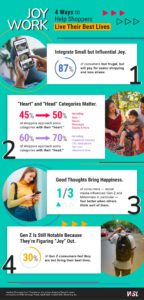The troubles of the past three years have been overwhelming, and consumers are ready to get some joy back into their lives. Joy happens in everyday experiences, including shopping, feeding the family, decorating and maintaining the home. Joy is essential to consumer feelings, confidence and loyalty. To learn the role of retail and brands, we set out to learn what people define as their “best lives.”
To Enter a Customer’s Best Life, Brands and Retailers Need a 5th ‘P’
We’re all familiar with the old-school “four Ps” of retail success: Product, Price, Placement (ease) and Promotion. Now let’s add Pleasure.
One in five consumers – 21% – are living their best lives, according to our latest 2023 How America Shops® report, “Leading Shoppers From Troubles to Joy.” The other 79% rank their life as “okay” or “not the best.”
Retailers and brands have long-term marketing opportunities to bring their customers joy, because despite only one-fifth living their “best life,” consumers are still seeking joy. In fact, following the pandemic, record inflation and social and political unrest, there’s likely an increased demand for it.
Our latest How America Shops® research indicates shopper joy can be discovered in everyday places.
Joy Factors Retailers and Brands Should Tap Into
We designed our survey to learn what consumer expectations matter most now, so retailers and brands can market to them in ways that restore joy to their lives. Following are the most actionable influencers of living their best lives today, based on our report findings:
Financial security (and insecurity):
Inflation is hurting a lot of people – 48% of those not living their best lives make less than $50,000. Money offers a sense of freedom. Half of our respondents find happiness in being able to buy little indulgences, like a good cup of coffee or food delivery. Those pleasures do not exist when you need to pay close to $5 for a gallon of milk.
Learn what brings customers the 5th “P” (Pleasure):
Half of our respondents said they want to make healthy choices, experience new things, and perform acts of kindness. If a brand or retailer’s marketing strategy can make their customers feel they are learning and giving back, then that’s a win.
Bring pleasure to Gen Z and Millennials:
Having grown up in a world of social media, one-third of young consumers want others to think well of them. Also, with social conscience being a big part of their lives, 30% feel their happiness is improved by supporting sustainability, donating to charity, or volunteering. Retailers’ ad brands should develop marketing strategies for Gen Z and Millennials that help them feel good about their commitments to social causes and give them places to let others know of their good deeds.
Delivering convenience, consistently:
Convenience is embedded in our culture. Online shopping is motivated more by convenience (60%) than value (53%).which does not always mean lowest price. For example, 30% to 40% of consumers choose prepared meals to eat at home, grocery delivery or pick- up (even if it costs more), and when they do cook, choosing pre-cut vegetables. Convenience crosses income groups but among younger shoppers, the share is up to 16 percentage points higher.
Joy Work – 4 Ways to Help Shoppers Live Their Best Lives
If retailers and brands invest a little more time in promoting Pleasure (aka Joy) as part of the shopping trip, they can cut a new marketing path; one that lifts the quality of their customers’ lives – and may deliver value worth paying more for.
Here are four “best life” guidelines, direct from the shopper which retailers and brands can integrate into their messaging online, in-store, and any media they choose.
1. Integrate small but influential joy.
While 87% of consumers feel frugal, they will pay for easier shopping and less stress. Retailers and brand would do well to showcase how they make the shopper’s journey easier or faster – across a product’s life, from how it is found to how it is used. They also can emphasize news that takes the form of cultural values such as fair practices, product sourcing and healthier advances.
2. “Heart” and “head” categories matter.
Shoppers approach some categories (including baby, beauty, some beverages, and snacks) with their ” heart,” choosing what they want because it makes them feel good. Other categories are bought with their “head,” putting practicality and price first in categories such as pet food, household cleaners and vitamins. On-shelf and online wording should emphasize “heart” and “head” qualities – and how the goal is to move a “head” category onto the ”heart” list!
3. Good thoughts bring happiness.
One-third of consumers – social media-influenced Gen Z and Millennials in particular – feel better when others think well of them. Marketing a brand or retail chain as popular, the place to be and connecting on trending sites will help consumers feel better about themselves and by extension, the brand or retailer.
4. Gen Z is still notable because they’re figuring “joy” out.
30% of Gen Z consumers feel they are not living their best lives. This young demographic is more interested than older consumers in having time for themselves and pursuing activities they like to do, including having a pet. They want the lowest prices, but will also support sustainability, inclusion, and fairness.
Need Help Discovering Your Sources of Customer Pleasure?
WSL Strategic Retail is already researching our next hot topic for retailers and brands. If there is a shopper trend or retail innovation you’d like to learn more about, let us know how we can help.



